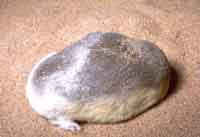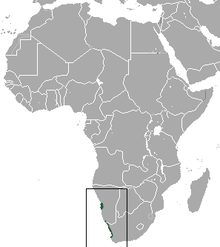
Marsupial moles, the Notoryctidae family, are two species of highly specialized marsupial mammals that are found in the Australian interior. They are small fossorial marsupials that anatomically converge on fossorial placental mammals, such as extant golden moles (Chrysochloridae) and extinct epoicotheres (Pholidota). The species are:

Golden moles are small insectivorous burrowing mammals endemic to Sub-Saharan Africa. They comprise the family Chrysochloridae and as such they are taxonomically distinct from the true moles, family Talpidae, and other mole-like families, all of which, to various degrees, they resemble as a result of evolutionary convergence. There are 21 species. Some are relatively common, whereas others are rare and endangered.
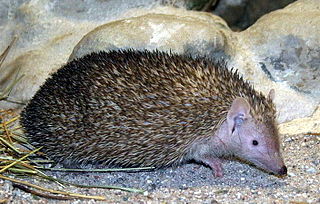
The clade Afrosoricida contains the golden moles of Southern Africa, the otter shrews of equatorial Africa and the tenrecs of Madagascar. These three groups of small mammals were for most of the 19th and 20th centuries regarded as a part of the Insectivora or Lipotyphla, but both of those groups, as traditionally used, are polyphyletic.

The family Talpidae includes the moles who are small insectivorous mammals of the order Eulipotyphla. Talpids are all digging animals to various degrees: moles are completely subterranean animals; shrew moles and shrew-like moles somewhat less so; and desmans, while basically aquatic, excavate dry sleeping chambers; whilst the quite unique star-nosed mole is equally adept in the water and underground. Talpids are found across the Northern Hemisphere of Eurasia and North America, and range as far south as the montane regions of tropical Southeast Asia.
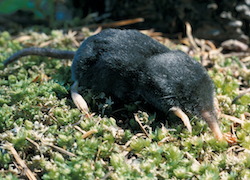
The American shrew mole is the smallest species of mole. It is the only living member of the genus Neurotrichus and the tribe Neurotrichini. It is also known as Gibb's shrew mole and least shrew mole. It is not closely related to the Asian shrew mole. The reason that it is called a "shrew mole" instead of being called either a "shrew" or a "mole" is because of its fur, which is a characteristic of shrews and its large head and heavy dentition, which is characteristic of moles.

The Townsend's mole is a fossorial mammal in the family Talpidae, and is the largest North American mole. It was named after the American naturalist John Kirk Townsend. The name was selected at the request of Thomas Nuttall as a patronym to honor Townsend's contribution.

A fossorial animal is one that is adapted to digging and which lives primarily underground. Examples of fossorial vertebrates are badgers, naked mole-rats, meerkats, armadillos, wombats, and mole salamanders. Among invertebrates, many molluscs, insects, and arachnids are fossorial.

Juliana's golden mole is a golden mole endemic to South Africa. It is listed as an endangered species due to habitat loss and a restricted range. Golden moles are an ancient group of mammals that live mostly below ground. The eponymous Juliana is Juliana Meester, the wife of the South African zoologist who named this species.
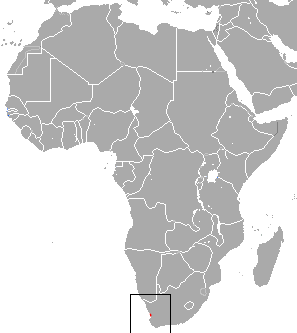
Van Zyl's golden mole is a golden mole endemic to the Western Cape Province, South Africa. It is listed as an endangered species due to habitat loss. Golden moles are an ancient group of mammals who live mostly below ground. They have shiny coats of dense fur and a streamlined, formless appearance. They have no visible eyes or ears; in fact, they are blind – the small eyes are covered with hairy skin. The ears are small and are hidden in the animal's fur.

The northern marsupial mole or kakarratul is a marsupial in the family Notoryctidae, an endemic animal of arid regions of Central Australia. It lives in the loose sand of dunes and river plains in the desert, spending nearly its entire life beneath ground. The facial features are reduced or absent, their small and strong body, weighing little more the 30 grams, is extremely specialised to moving through sand in search of prey. The species is elusive and it is one of the most poorly understood mammals of Australia.

Amblysomus is a genus of the golden mole family, Chrysochloridae, comprising five species of the small, insect-eating, burrowing mammals endemic to Southern Africa. All five species can be found in South Africa and some are also found in Eswatini and Lesotho.

Marley's golden mole is a species of burrowing mammal in the golden mole family, Chrysochloridae. It is found in South Africa and possibly Eswatini. It has been separated from Amblysomus hottentotus by Bronner. Its natural habitat is indigenous forests and moist grassland, and also gardens. It is classified as Endangered in the IUCN Red List of Threatened Species. The main threats it faces are habitat degradation, either through overgrazing by cattle or the removal of vegetation for firewood, and urbanization.

De Winton's golden mole is a species of mammal in the family Chrysochloridae. It is endemic to South Africa. Its natural habitats are subtropical dry shrubland, Mediterranean-type shrubby vegetation, and sandy shores. It is threatened by habitat destruction and is "critically endangered". It was named after British zoologist William Edward de Winton.
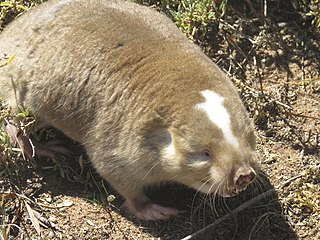
The Cape dune mole-rat is a species of solitary burrowing rodent in the family Bathyergidae. It is endemic to South Africa and named for the Cape of Good Hope.
The Mendoza tuco-tuco is a species of rodent in the family Ctenomyidae.

The greater blind mole-rat is a species of rodent in the family Spalacidae. It is found in Russia and Ukraine.

The northeast African mole-rat is a species of rodent in the family Spalacidae and is found in Ethiopia, Somalia, and northwest Kenya. Its natural habitats are subtropical or tropical moist montane forests, dry savanna, high-altitude shrubland and grassland. It lives a solitary existence underground and produces a small litter of pups twice a year, in the two rainy seasons. Some taxonomic authorities lump this species, along with a number of others in the genus, in which case the English name East African mole-rat is used.

Seismic or vibrational communication is a process of conveying information through mechanical (seismic) vibrations of the substrate. The substrate may be the earth, a plant stem or leaf, the surface of a body of water, a spider's web, a honeycomb, or any of the myriad types of soil substrates. Seismic cues are generally conveyed by surface Rayleigh or bending waves generated through vibrations on the substrate, or acoustical waves that couple with the substrate. Vibrational communication is an ancient sensory modality and it is widespread in the animal kingdom where it has evolved several times independently. It has been reported in mammals, birds, reptiles, amphibians, insects, arachnids, crustaceans and nematode worms. Vibrations and other communication channels are not necessarily mutually exclusive, but can be used in multi-modal communication.
Haacke's legless skink, also known commonly as Brain's legless skink and Brain's blind legless skink, is a species of lizard in the family Scincidae. The species is endemic to Namibia.
